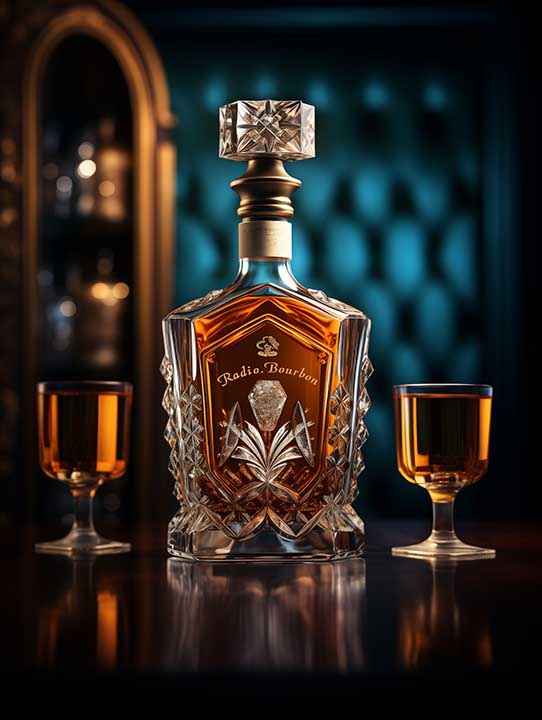The Art of Bourbon: A Journey Through Time and Taste
“While Radio.Bourbon began as a reference to Bourbon Street and the Mardi Gras culture, we also share a love of the bourbon experience.”
Bourbon, often referred to as America’s native spirit, is a beloved and iconic drink that has captured the hearts and palates of people all over the world. With its rich history, complex flavors, and meticulous craftsmanship, bourbon is more than just a beverage—it is an art form. We will take a deep dive into the art of bourbon, exploring its origins, production process, and the unique characteristics that make it a true masterpiece.
Origins and History
The story of bourbon begins in the late 18th century in the state of Kentucky, which would later become known as the birthplace of this beloved spirit. The exact origins of bourbon are somewhat debated, but it is widely believed that it was first distilled by early settlers who brought their knowledge of whiskey-making from Scotland and Ireland.
The name “bourbon” itself has an interesting history. It is said to have been derived from Bourbon County, Kentucky, where the spirit was first produced. However, the true origin of the name remains a subject of debate. What is certain is that bourbon quickly gained popularity and became an integral part of American culture.
Production Process
The production of bourbon is a meticulous and time-honored process that requires skill, patience, and attention to detail. It all starts with the selection of the grains, which must consist of at least 51% corn. The remaining grains typically include malted barley, rye, and wheat, each adding its own unique flavor profile to the final product.
Once the grains are selected, they are ground and mixed with water to create a mash. This mash is then fermented using yeast, which converts the sugars into alcohol. The resulting liquid, known as the “distiller’s beer,” is then distilled in copper stills to separate the alcohol from impurities.
After distillation, the bourbon is aged in charred oak barrels, a process that gives the spirit its distinctive flavor and color. The aging process is crucial, as it allows the bourbon to develop complex flavors and aromas. By law, bourbon must be aged for a minimum of two years, although many premium bourbons are aged for much longer.
Characteristics and Tasting Notes
One of the most fascinating aspects of bourbon is its wide range of flavors and aromas. Each bourbon has its own unique character, influenced by factors such as the grains used, the aging process, and the distillery’s techniques. However, there are some common characteristics that are often associated with bourbon.
Bourbon is known for its rich, full-bodied flavor, with notes of caramel, vanilla, and oak. The sweetness of the corn is balanced by the spiciness of the rye or the smoothness of the wheat, creating a harmonious blend of flavors. The aging process adds depth and complexity, with hints of toffee, chocolate, and dried fruits.
When tasting bourbon, it is important to take your time and savor the experience. Start by observing the color, which can range from golden amber to deep mahogany. Swirl the bourbon in your glass to release its aromas, and take a moment to appreciate the bouquet of scents that waft up.
On the palate, bourbon should be smooth and well-balanced, with a pleasant warmth that lingers. Take small sips and let the flavors unfold on your tongue. Pay attention to the different layers of flavor, from the initial sweetness to the lingering finish.
The Art of Bourbon Appreciation
Appreciating bourbon is not just about the taste—it is also about the experience and the stories behind each bottle. Bourbon enthusiasts often enjoy exploring different distilleries, learning about their unique production methods, and collecting rare and limited-edition releases.
Bourbon tastings and festivals are popular events where enthusiasts can come together to share their passion for this remarkable spirit. These gatherings provide an opportunity to sample a variety of bourbons, learn from experts, and discover new favorites.
In recent years, there has been a resurgence of craft distilleries, adding to the diversity and innovation within the bourbon industry. These smaller, artisanal producers are pushing the boundaries of traditional bourbon-making, experimenting with different grains, aging techniques, and flavor profiles.
Conclusion
The art of bourbon is a fascinating journey that combines history, craftsmanship, and a deep appreciation for flavor. From its humble beginnings in Kentucky to its status as a global icon, bourbon has captured the hearts and palates of people around the world.
Whether enjoyed neat, on the rocks, or in a classic cocktail, bourbon offers a sensory experience like no other. Its complex flavors, rich history, and the passion of those who craft it make bourbon a true work of art. So next time you raise a glass of bourbon, take a moment to appreciate the artistry that went into creating this timeless spirit.





